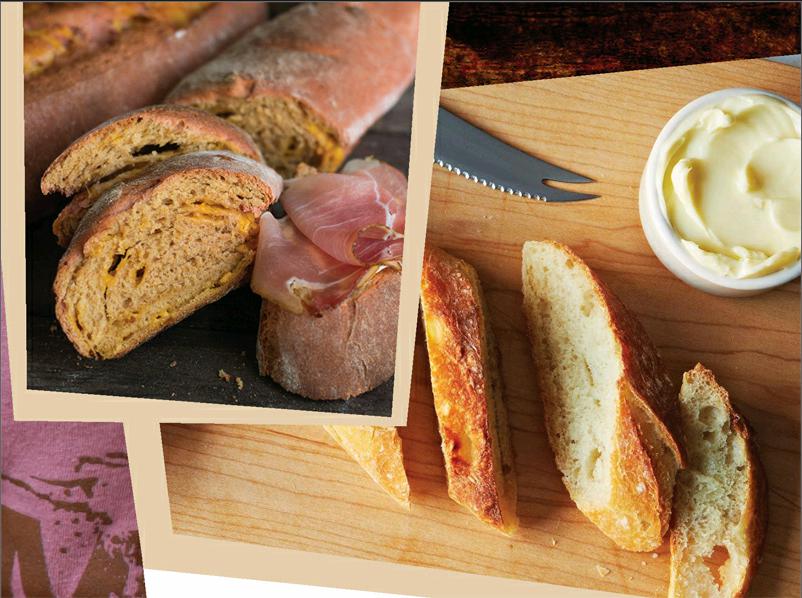History of the Baguette: Legends, Laws, and Lengthy Loaves 法棍的传奇身世
Margo+Lestz++译+赵青奇

What could be more traditionally French than the baguette, that long slender loaf of bread that has become an instantly recognised symbol of France? At any hour of the day, on the streets of any village, town, or city, you are likely to see the French strolling along with one of these elongated2) loaves tucked under their arm. Thats because this ubiquitous3) bread can accompany their breakfast, lunch, or dinner.
The word “baguette” simply means wand4), baton5), or stick and refers to the shape of the bread. This term became attached to the thin, round sticks of bread we know today in the early twentieth century. But the baguettes history may go back much further.
No one knows exactly when or why this French loaf took on its current shape, but there are several stories, and even some laws that give us clues to the baguettes heritage.
One patriotic tale explains the possible origin of the baguette (but not its shape) by linking it to the French Revolution. Lack of bread was the principal complaint from the people of Paris and it played a big part in the overthrow of the monarchy. Bread was the mainstay6) of the French diet and they were tired of watching the nobility eat copious7) amounts of fine white loaves while they faced shortages and had to make do with bread that was barely edible.
So after the Revolution, making sure everyone had quality daily bread was high on the priority list. In 1793, the Convention (the post-Revolution government) made a law stating:
“Richness and poverty must both disappear from the government of equality. It will no longer make a bread of wheat for the rich and a bread of bran8) for the poor. All bakers will be held, under the penalty of imprisonment, to make only one type of bread: The Bread of Equality.”
Some might propose that since the baguette is enjoyed by rich and poor alike, it could have been this Bread of Equality. Its a charming theory and a very French idea of Liberty, Equality, and Fraternity9), but could this law truly have created the forerunner of our beloved baguette?
Or did Napoleon Bonaparte have something to do with it? Another story claims that Napoleon passed a law decreeing10) that bread for his soldiers should be made in long slender loaves of exact measurements to fit into a special pocket on their uniforms. Since those measurements were close to the size of a modern baguette, certain people think this might be when the bread first took on its current form. If this is true, perhaps we have Napoleon to thank for the shape of our daily baguette.

Or was it the Paris metro? A different anecdote affirms that when the metro system was being built in Paris, the workmen from different regions just couldnt get along and the overseer of the project was concerned about violence in the dark, underground tunnels. At that time, everyone carried a knife to cut their bread, so the supervisor went to the bakery to request loaves that didnt need to be cut. A loaf of bread was regulated by weight, so in order to make it thin enough to be easily torn, it ended up being long and slender. Considering this, we might owe our beloved baguette to rowdy11) metro workmen.
Whenever and for whatever reason the first wand-shaped breads appeared, by the mid-1800s in Paris, they were everywhere. But these werent the French loaves that we see today. No, they were baguettes on steroids12). Many foreign visitors marvelled at the extraordinary lengths of the Parisian bread they saw.
They described loaves of bread 6 feet (2 metres) long being delivered by women carrying them stacked13) horizontally, like firewood, in a frame on their backs. Housemaids were on the streets at 6:00 in the morning carrying these long loaves home for their employers breakfast. In the afternoon, young boys could be seen using these lengthy baguettes as pretend swords and engaging in mock battles before the bread made its way to the family table. One visitor remarked that in a restaurant, the baker came in and stacked loaves 6~8 feet (2~2.5 metres) long in the corner like a bundle14) of sticks. Another describes the bread having to be laid on the dining table lengthwise because it was longer than the table was wide.
Those long breads that made such an impression on nineteenth century tourists must have been the forerunner of todays more manageably sized baguette. The modern, shorter version seems to have come into being in the 1920s, when a law was passed prohibiting bakers from working between the hours of 10:00 p.m. and 4:00 a.m. The current baguette was probably developed because its thin form allowed it to cook faster. The baker could start at 4:00 in the morning and the baguettes would be finished in time for the first customers breakfast. It was during this time that the term “baguette” first became associated with the slender loaves that are seen everywhere in France today.
Bread has always been important to the French, and for centuries, it was their main food source. Today, even though bread is an accompaniment to a meal instead of the main course, it still plays an important part in French life—and the most popular bread in France is the baguette. Since there are boulangeries (bakeries) everywhere in France, theres never an excuse for not having a nice crunchy baguette with every meal. And while youre walking home nibbling15) on the end of your baguette, you can ponder the French Revolution, Napoleon, and the Paris metro … and be thankful that youre not trying to manoeuvre16) a 6-foot (2-metre) long loaf of bread down the street.
还有什么能比法棍更具法国传统特色呢?这种细长的面包已经成为一种一望即知的法国的象征。在一天中的任何时候,在任何一个乡村、城镇或城市的街头,你都可能看到腋下夹着一根长条面包漫步的法国人,那是因为这种随处可见的面包能够作为他们一日三餐的搭档。
“baguette”一词的意思就是棒子、棍子或杆子,它指的是这种面包的形状。这个词用来指我们今天所熟悉的棍状细圆面包是在20世纪初。不过,法棍的历史可能还要早得多。
没人知道到底是在何时、因何缘故这种法国面包开始形成如今的形状,不过倒有一些故事甚至法律为我们提供了追溯法棍身世的线索。
根据一则爱国故事的解释,法棍(而非其形状)的起源可能跟法国大革命有关。面包短缺是巴黎当时民怨沸腾的主要原因,在法国王室倒台中起到了重要作用。当时,面包是法国人的主要食物。人们厌倦了只见王公贵族享用无尽的精制白面包,而他们却食不果腹,只能凑合吃几乎无法下咽的面包度日。
因此,大革命之后,确保人人每天都能吃上优质的面包就成为重中之重。1793年,国民公会(大革命后的政府)制定了一项法律,该法律宣布:
“平等政府之下,必无贫富之别。富者食麦、贫者食麸之情形当不复存在。所有面包师只做一种面包:平等面包。违令者处监禁。”
有人可能会提出,既然富人和穷人都喜欢法棍,法棍可能就是这个“平等面包”。这种观点颇具魅力,也很有“自由、平等、博爱”的法国色彩,但果真是这条法律催生出我们喜爱的法棍的前身吗?
或者拿破仑·波拿巴跟法棍有点渊源?还有一个故事声称,拿破仑曾经颁布一项法律,规定他手下的士兵所吃的面包必须做成有精确规格的细长条状,以便放进军装的一个专用口袋。由于这个规格接近如今法棍的大小,一些人认为法棍可能就是从那时开始变成现在这个样子的。如果情况属实,或许我们还得感谢拿破仑赋予了我们每天所吃的法棍这样的形状。
抑或这事跟巴黎地铁有关?另有传闻言之凿凿地表示,巴黎建地铁的时候,来自不同地区的工人彼此不和,工程的监工担心黑暗的地下隧道中发生暴力事件。那个年代,人人都随身带着一把刀用于切面包,因此监工找到面包房,要求做出无需刀切的面包。当时的一条面包有重量方面的规定,因此为了使面包足够细,便于撕开,面包最后就做得又长又细。这么说来,我们喜爱的法棍或许该归功于好斗的地铁工人。
无论第一条棍状面包到底何时何故出现,到19世纪中叶时,巴黎已到处可见它们的身影。不过,这些并不是我们今天所看到的法式长棍面包,而是加大号的法棍。当时很多外国游客见到巴黎的这种超长面包都大为惊叹。
他们描述道,面包有六英尺(两米)长,运送面包的妇女背上有一个架子,面包就像柴火一样水平叠放在架子上。清晨6点,女佣们身背这种长面包走在街上,回家给雇主们做早餐。下午,在面包端上家里的餐桌之前,能够看见小男孩们用这种长法棍当剑,相互打斗嬉戏。一位游客说道,在一家餐馆,面包师走进店里,将6~8英尺(2~2.5米)长的面包像一捆木棍一样堆放在角落。还有游客描述道,由于面包比餐桌的宽度还长,所以只能纵向放在餐桌上。
令19世纪游客过目难忘的那些长面包想必就是今天大小更易携带的法棍的前身。当今缩短版的法棍似乎于20世纪20年代就诞生了,当时法国颁布了一项法律,禁止面包师在晚上10点到凌晨4点之间工作。如今这种法棍之所以出现,可能是因为其细细的形状有助于加快烘焙。面包师可以清晨4点开工,在第一批客人用早餐前及时做好法棍。正是在此期间,“法棍”这个词开始与今天在法国遍地可见的细长面包联系起来。
面包对法国人来说一直都很重要,在过去数百年里是他们的主要食物来源。如今,面包尽管只是用于佐餐而非主菜,却仍然在法国人的生活中扮演着重要角色—而法国最受欢迎的面包就是法棍。面包店在法国遍地都是,因此实在没有理由每顿不来上一根松脆的法棍。当你啃着法棍走在回家的路上,不妨怀想一下法国大革命、拿破仑、巴黎地铁……同时应当庆幸你现在不是在街上试图搬弄一根六英尺(两米)长的面包。
1. baguette [b??ɡet] n. 法式长面包,(法国)棍子面包
2. elongated [?i?l???ɡe?t?d] adj. 过于细长的
3. ubiquitous [ju??b?kw?t?s] adj. 普遍存在的,无所不在的
4. wand [w?nd] n. 棒,棍,竿
5. baton [?b?t?n] n. 短棍,短棒
6. mainstay [?me?n?ste?] n. 主要依靠,主要资源,支柱
7. copious [?k??pi?s] adj. 充裕的;大量的
8. bran [br?n] n. 糠,麦麸
9. fraternity [fr??t??(r)n?ti] n. 友爱,博爱
10. decree [d??kri?] vt. 命令;颁布
11. rowdy [?ra?di] adj. 好争吵的;喧闹的;粗暴的
12. sth. on steroids:某物大(强壮、出色等)得多
13. stack [st?k] vt. 把……叠成堆
14. bundle [?b?nd(?)l] n. 捆,束,包
15. nibble [?n?b(?)l] vi. 啃;一点一点地咬(或吃)
16. manoeuvre [m??nu?v?(r)] vt. (敏捷或巧妙地)操纵,控制

